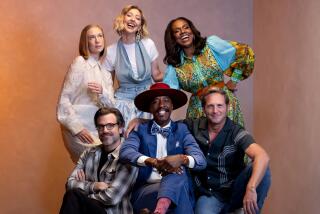Novel Treatment : GIRLS IN SUITS AT LUNCH Scenes From Real Life<i> by Deanne Stillman (A Dolphin Book</i> / <i> Doubleday: $9.95; 216 pp.)</i>
- Share via
This may be the definitive Hollywood novel: Although it isn’t about people who make movies, it is perfectly suited to the 12-second attention span endemic to the industry. Humorist Deanne Stillman delivers exactly what she promises--scenes, dialogue only, with very little connective prose. You may raise the question of truth-in-advertising here: Perhaps a work of fiction that lacks descriptive phrases should not be called a novel; “Girls in Suits at Lunch” actually seems to define a new category, the transcribed sitcom. Whatever it is, it is designed for (and seemingly designed by) people who define novel as a book that someone lower down on the entertainment ladder will reduce to a half-page synopsis for them.
The consumer warning aside, Stillman’s vignettes do have their moments. She dishes up three lunches and 11 between-meal snacks in this book, all of them addressing the question of whether best friends Jane Lazarus and Trish Bryant will ever find, recognize and be able to keep true love, with a few time outs for family matters. Look around the restaurant where Jane and Trish meet, and you’ll see Andre Gregory and the ghost of Truman Capote, those masters of mealtime fiction, at nearby tables. Clearly, Stillman hopes to emulate her predecessors and elevate table conversation at least to the level of high comic sociology, if not art.
Jane is in her mid-30s, the artsier of the pair, a successful writer with charmingly idiosyncratic (and according to the author, stereotypically Semitic) neuroses. Trish is a more restrained version of today’s single woman--a trim, fit, junior partner in a law firm. They spend their lunches cracking wise about commitment and condoms, and their hours apart trying to cope with three different beaus named Larry (Jane) and a mom who has rediscovered her dormant sex life (Trish).
In Jane, Stillman has drawn a nicely etched-in-acid portrait of a woman who protests too much, who makes a lot of noise about how independent she is in between sprints to the public phone to call her latest boyfriend’s answering machine. Stillman seems to be more at ease writing about this character than about Trish. When the lady lawyer steps center stage with her date, Stillman relies on used literary goods--Woody Allen’s conversation with subtitles from “Annie Hall”--to get a laugh.
Eventually one woman weds, the other doesn’t, but these are more stick-figure skits, only loosely related to each other, than a fleshed-out story. As skits, they cry out to be translated to the screen, to be endowed with a visual dimension. Stillman has a sharp ear for the way people feint to keep a potentially painful conversation from getting out of hand--the ‘Quest for Ecstasy’ section, “in which Jane and her steady boyfriend ponder the flight path of passion,” is a great, zigzagging Mayday of a doomed conversation, and the chance encounter of the three Larrys in Jane’s loft sounds great. It has no look, though, beyond what the reader imagines. Without any prose padding, “Girls in Suits” seems 14 comedy sketches in search of a producer.
Don’t get me wrong: It’s always fun to run into women characters who are smart, rude and not easily impressed, and there is a bracing quality to the one-liners. Still, it’s disconcerting to realize that one imagines Trish to be a blonde even though there is not a word about her physical appearance, save that she is physically fit and wears suits, which could describe three-quarters of the female population of West Los Angeles.
To paraphrase Spencer Tracy’s appraisal of Katherine Hepburn in “Pat and Mike:” There isn’t much of her, but what there is--intermittently, in this case--is cherce.
More to Read
Sign up for our Book Club newsletter
Get the latest news, events and more from the Los Angeles Times Book Club, and help us get L.A. reading and talking.
You may occasionally receive promotional content from the Los Angeles Times.







